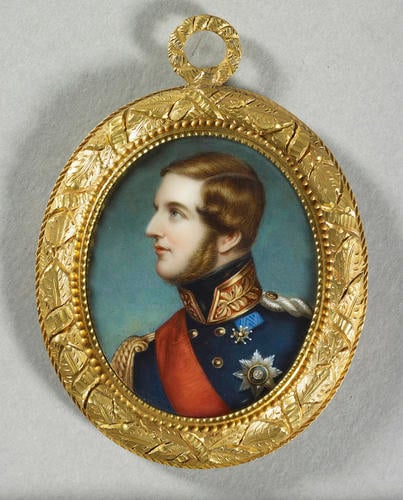William Essex (1784-1869)
George V, King of Hanover (1819-1878) when Crown Prince of Hanover Signed and dated 1846
Enamel on gold | 4.8 x 3.9 cm (support, canvas/panel/stretcher external) | RCIN 421890
-
William Essex trained as an enamel painter in the workshop of Charles Muss (1779 – 1824), Enamel Painter to William IV. Essex first exhibited at the Royal Academy in 1818 and throughout the 1820s and early 1830s built up a successful practice, working chiefly in enamel. William Essex must have had his first introduction to court circles through Charles Muss. He may initially have worked in collaboration with his teacher, but by 1827 was earning his own commissions from George IV. In 1834 Essex painted an enamel miniature of Charlotte, Duchess of Northumberland, governess to Queen Victoria, after Sir Thomas Lawrence; although he was already well established in royal circles, his patronage by the Duchess of Northumberland may have been an additional factor that contributed to his appointment as Enamel Painter to Queen Victoria in 1837 and Enamel Painter to Prince Albert in 1841. Queen Victoria employed Essex to make numerous enamel copies of portraits of her after Franz Xaver Winterhalter, which were set into bracelets and distributed as gifts. He also made numerous copies of portraits of her relatives and contemporaries. Most of these were commissioned within the same year as the original on which they were based, and were often given by Queen Victoria to Prince Albert. He also made historical copies of early miniatures and portraits at Windsor. Despite Essex's ostensible success, however, he fell into poverty in his later years and was forced to request that the Queen supplement his artist's annuity of £40 with a pension.
A pair with a miniature of Marie, Queen of Hanover (421889), the source for this enamel is a full-length oil painting by Conrad l'Allemand (1809 – 80), known from a copy by Carl Oesterley (1805 – 91) given to Queen Victoria by the King of Hanover in 1854 (405102).
George, 2nd Duke of Cumberland, Crown Prince of Hanover, later George V, King of Hanover, only son of Ernest Augustus, King of Hanover, and Frederica, daughter of Charles, Duke of Mecklenburg-Strelitz, was blinded in a childhood accident. He married, in 1843, Marie, eldest daughter of Joseph, Duke of Saxe-Altenburg, and they had a son and two daughters. He succeeded his father as King of Hanover but was deposed after the Austro-Prussian War in 1866, and died in Paris in 1878. He was buried, as a Prince of Great Britain, in St George's Chapel, Windsor.
Signed, dated and inscribed on the counter-enamel in black paint: George Crown Prince / of Hanover / Painted by W. Essex / Enamel painter to Her / Majesty & H.R.H. Prince Albert / after L'Allemand 1846.Provenance
First recorded in the Royal Collection during the reign of Queen Victoria
-
Creator(s)
-
Medium and techniques
Enamel on gold
Measurements
4.8 x 3.9 cm (support, canvas/panel/stretcher external)
6.4 x 5.6 cm (frame, external)
Category
Object type(s)
Subject(s)
Other number(s)








